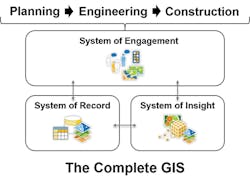Latest from Home
Deployment Home Runs Require an Evolved GIS System —
Did you know that a baseball player’s hitting power is largely generated from their hips? Sure, the hands, wrists, and upper body, all play a role, but the hips are the core foundations to allow a baseball player to hit a home run.
The same concept can be applied to the telecom industry. If 5G is the home run that everyone strives to hit, fiber is the core foundation that generates the home-run potential.
The amazing promise of 5G doesn’t mean fiber is dead — it’s quite the opposite. It means more fiber will be added to the transport network to support all those home runs. Fiber densification will occur for years to come, and traditional carriers will increase the outsourcing of design and construction of these networks to keep up with their 5G wireless network buildout demand. Automated fiber route planning and design, along with project job tracking will be key to optimizing fiber routes and making sure designs are not happening on top of each other.
InvisiLight® Solution for Deploying Fiber
April 2, 2022Go to Market Faster. Speed up Network Deployment
April 2, 2022Episode 10: Fiber Optic Closure Specs Explained…
April 1, 2022Food for Thought from Our 2022 ICT Visionaries
April 1, 2022Verizon’s One Fiber initiative is a great example of a carrier rallying around their broadband transport network and stating that it doesn’t matter if they are building fiber for enterprise B2B services or small cells, they’ll be strategically designing and building fiber that supports all their broadband services. This approach eliminates stove-piped design and buildout from different teams across Verizon, and across their contractors.
So, with all the fiber planning, engineering, and construction, that will occur to support 5G, what’s the one aspect that ties each stage of the design process together and can bring design firms, contractors, and carriers, together? Location.
Location is creating a common reference system. Maps are used today to plan fiber routes, redline in the field, perform engineering, submit permits, and provide construction prints. I am yet to meet a telecom organization who hasn’t tried to get maps to someone inside or outside the company.
Although all these workflows are inherently geographic, output and work product often devolve to paper maps or spreadsheets. Sharing these flat files creates confusion and chaos, creating many uncertainties. Who created this design? When was it last updated? Do I have the authoritative version? Processes are delayed, and permits are often lost, due to the sheer amount of time it takes to decipher uncontrolled documentation and workflows.
Since location is the unifying factor in the design process, and everyday more designs are being created to support fiber densification, design firms and carriers are looking to a more complete enterprise approach to mapping. If each party involved in planning, design, permitting, construction, and operations, used the same set of maps, a near real-time operational awareness can be achieved. Everyone with a stake in the project should know exactly the current status, challenges, and future plans, all within a context everyone understands: a map.
What should we call this centralized set of authoritative maps and data? We suggest the term Complete GIS. Geographic Information Systems (GIS) exist within many telecommunications and design/construction shops already, and often serve as a geospatial representation of the network itself. A Complete GIS, however, is more than just a digital twin of the network managed only by professional mappers with high-powered tools.
The key is sharing and collaboration around maps and engineering tools, making geospatial technology available on any device, any system, anywhere, and anytime.
• The ideal system is made up of an authoritative system of record for managing designs and providing a real-time network view of any network technology: fiber, HFC, or wireless.
• It also must offer a process of engagement for easily sharing those designs via web and mobile apps to easily facilitate field walkout surveys and collaboration between teams both inside and outside the organization.
• Ideally, it has a system of insight that leverages advanced analytics with AI/ML for strategic planning and fiber design automation.
Three systems working allow teams to manage and track fiber designs and buildout projects in one mapping platform from initial desktop surveys to construction and project close-out. Most telecom organizations have versions of each of these systems in production right now, however they rarely interact with one another and certainly not natively. While siloed mapping and GIS tools may offer specialized capabilities for engineers, or construction teams, or project managers, a best practice and process offers these capabilities across integrated maps and apps.
ArcGIS apps and maps
A Better 5G Densification Game Plan
With this type of system in place, an organization with a fiber densification project will accomplish the following workflows all without passing a single sheet of paper or static map file back and forth:
• Make data-driven decisions regarding desirable markets by evaluating maps showing population growth, daytime population, existing network capacity, existing fiber, socioeconomic variables, business locations, and/or other business data.
• Digitally pass that map to Design, who would use automated analysis tools and AI/ML algorithms to first suggest an optimal design, then use aerial photography or street level imagery to refine.
• Share the proposed design to Employees or Contractors to perform field audits or walkout surveys. The Field Worker would open the same map with a mobile app and perform edits or redlines digitally within the app, whether connected or disconnected.
• Incorporate notes and changes from the walkout survey into the design.
• Generate permitting documents, bills of material, final design maps, and other construction documents and share with appropriate Contractor or Construction staff.
• Provide Supervisory and Management Teams with a near real-time view of all activities to monitor permit status, construction progress, invoicing, or any other aspect of the project work.
• Incorporate as-built changes or notes into the production network maps once received from Construction.
• Notify Operations to light new equipment as soon as it’s entered into the system of record.
• Alert Sales and Marketing to sell services on new network as soon as the site is operational.
Again, many organizations have tools and systems in place to perform all of these steps. However, those tools rarely use the same set of authoritative maps or data, and don’t often integrate seamlessly without major customization effort. More often than not, staff resort to passing spreadsheets, unsecure static map files, or pieces of paper, back and forth.
Have you ever had a permit expire because you didn’t begin construction in time? Have you ever had to pay a field crew to sit around and do nothing because the final design package wasn’t ready yet, or no one could find it? What about not knowing for 6 months that a section of network was completely constructed but lost revenue because sales didn’t know it was operational?
Like this Article?
Subscribe to ISE magazine and start receiving your FREE monthly copy today!
A successful baseball team ensures every player knows the game plan. When it comes to 5G, the same is true. By implementing practices and processes, your 5G team can secure a long-term winning record.
Resource
Verizon’s One Fiber initiative: https://www.lightreading.com/mobile/5g/the-story-behind-verizons-5g-secret-weapon/d/d-id/752625










